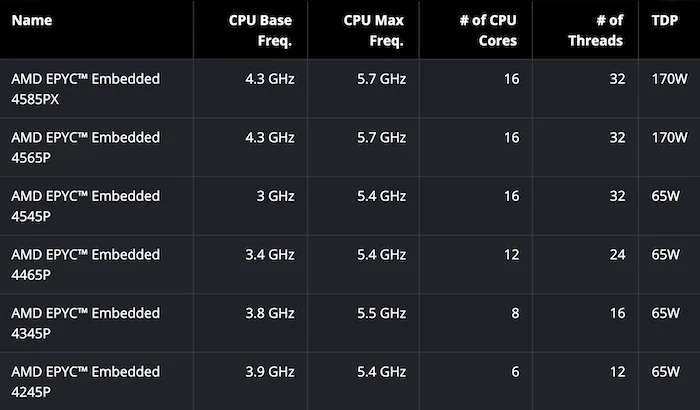The new processors bring Zen 5 performance, PCIe 5.0, and DDR5 to rugged edge applications, pairing high-throughput compute with longevity and security features.
AMD has launched its EPYC Embedded 4005 Seriesprocessors to serve the needs of low-latency, high-bandwidth applications at the industrial and network edge. Built on the company’s latest Zen 5 architecture, the processors offer up to 16 cores, support for DDR5-5600, and PCIe 5.0 connectivity, all in a platform designed for seven years of availability and rugged, 24/7 operation.

EPYC Embedded 4005 processors leverage AMD's Zen 5 x86 architecture, integrating up to 16 cores and 32 threads in a compact 4-nm chiplet design.
With these parts, AMD aims to meet the growing demand for deterministic performance, scalability, and long product lifecycles in sectors like network security, uCPE, industrial control, and edge AI inference. The processors are available globally and are expected to be adopted by OEMs building systems that demand both compute headroom and hardened reliability.
Balancing Bandwidth and Latency at the Edge
With the launch of the EPYC Embedded 4005 series, AMD is extending its Zen 5 architecture into the embedded market, targeting edge applications where deterministic performance and rugged longevity are needed. The new processors scale from 6 to 16 cores (32 threads) and are built on a 4-nm process, offering high clock speeds, wide memory bandwidth, and up to 128 MB of shared L3 cache.

Previous EPYC Embedded model specifications.
Unlike high-density server parts, the EPYC Embedded 4005 series is built to operate in thermally constrained environments with configurable TDPs ranging from 65 W to 170 W. The AM5 socket platform gives embedded designers access to DDR5-5600 memory with ECC and 28 lanes of PCIe 5.0 across 11 root ports for supporting multi-port NICs, high-speed NVMe storage, and accelerators in small form factors. It’s a combination that enables deterministic low-latency processing and rapid I/O without relying on discrete southbridge components or custom chipsets.
Designed for Longevity and Serviceability
While performance specs draw attention, the longevity story is what positions the 4005 series for embedded use. AMD has committed to a seven-year availability window, making the platform suitable for OEMs with extended product life cycles, field certifications, or difficult-to-service deployments. The processors support a wide range of standard and extended temperature environments. They also pair with RAS features such as ECC for memory and I/O, on-die parity, and support for AMD’s Infinity Guard security stack.
Staying on the AM5 socket also allows customers to scale their systems without redesigning the board or cooling solution. This enables a single embedded platform to serve multiple tiers of product offerings, from lower-end edge nodes with six cores to high-throughput network appliances with 16-core or X3D cache SKUs. For industrial or communications infrastructure vendors looking to consolidate performance and lifecycle requirements, the 4005 family offers a viable upgrade path with minimal redesign.
Targeting Real-Time Edge Compute
The EPYC Embedded 4005 family is clearly tuned for networking and industrial edge use cases. AMD is positioning these processors for workloads like next-generation firewalls, secure routers, and uCPE appliances, where packet processing throughput and secure boot are critical. The support for AVX-512 also makes them a fit for inline analytics and machine learning inference at the edge, without needing a separate accelerator or GPU.
Security is another area of focus. The 4005 series incorporates Infinity Guard, AMD’s hardware-based security framework, which protects sensitive data through features like Secure Boot, Memory Guard, and encrypted virtualization. These protections are especially valuable for edge deployments in untrusted or high-risk environments, where firmware tampering or remote exploits could compromise system integrity.
With high-performance Zen 5 cores, embedded lifecycle support, and enterprise-class I/O in a scalable platform, AMD’s EPYC Embedded 4005 series addresses a growing demand for secure, low-latency processing at the edge.
-
Tel
+86 180 2549 2789 -
Wechat

 BOM
BOM Cart()
Cart() English
English Russia
Russia Korean
Korean
